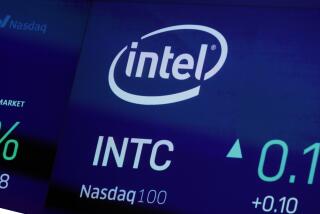Intel Spends on Promise of Tech’s Future
- Share via
Considering what’s happened in the last few years, it’s easy to forget that tech isn’t just about next quarter’s earnings but about the long-term evolution of the economy.
Maybe no company in the sector gets it better than Intel Corp. As its sales were falling by 20% over the last two years, and its profit plunging to a third of glory-day levels, the Santa Clara, Calif.-based chip maker kept writing checks. It spent almost $4 billion a year -- 15% of annual revenue -- on research and development. And it put more than $10 billion into expanding four advanced manufacturing plants.
Intel Chief Executive Craig Barrett explained it to analysts last month: “We don’t think innovation has slowed down; we don’t think technology has slowed down.”
In fact, Intel’s investments may bring forth a new industry, just as its mastery of microprocessors 20 years ago spurred the development of the personal computer.
The new focus: semiconductors for wireless communications. The firm wants its “Intel Inside” label to grace laptop computers, mobile telephones and digital gadgets that wirelessly connect to the Internet. It sees its future as manufacturing the essential circuitry for pervasive computing -- broadband devices that will compute and communicate at all times and places, in the home, at work, in the car, at the beach.
That vision has kept Intel in spending mode. The stock market seems unimpressed with Intel’s daring: Its stock price swan-dived to $13 a share last year from $76 in 2000. It closed Friday at $18.81 on Nasdaq.
Has the big company been foolhardy? Just the opposite.
“The risks were small compared to what could have happened if we hadn’t invested,” says Andy Bryant, Intel’s chief financial officer. If Intel had cut back in the downturn, “and somebody else had developed new technology and passed us, we’d be in a terrible situation.”
Intel and a lot of other U.S. companies know exactly how such “terrible” situations feel. In the early 1980s, Intel was mainly a producer of memory chips. In a business downdraft, it took the seemingly prudent course of cutting back on capital spending. Others didn’t. Japan’s memory chip makers, including NEC Corp. and Hitachi Ltd., expanded their production capabilities, counting on being prepared for an eventual upturn. And sure enough, when computer sales picked up again, they seized the leadership of global memory chip markets.
Intel Chairman Andrew S. Grove, who was company president back then, recalled that period in Wired magazine last year: “We had become marginalized by our Japanese competitors. One-third of the company was shut down and laid off, factories closing and all of that.”
Intel was fortunate: It had been developing microprocessors, more sophisticated products that became the essential circuitry of personal computers. As that market developed, the company grew to its present size and eminence. But it has never forgotten the lesson of the memory chip.
In the hard recent years, Bryant recalls, Intel’s senior officers sometimes “talked of expenditure cuts we had to make -- but we never cut back the investment in new technology.”
The technological edge that Intel strives for comes in manufacturing. The wafer fabrication plants it has upgraded and expanded in Hillsboro, Ore.; Rio Rancho, N.M.; and Leixlip, Ireland, which serves the European market, now handle a wafer of silicon that is 50% larger than the old standard, because doing so allows Intel to reduce costs of individual chips dramatically.
Engineers are pushing the envelope at these plants to etch transistors 90 nanometers in size -- one-tenth the width of a human hair -- onto the chips, so that more capability can be packed into each bit of silicon. Intel thus can deliver more capacity at lower cost, and make life difficult for competitors. Bryant notes that the firm’s wafer fabrication plants are so technologically advanced that, for security reasons, the U.S. government won’t allow Intel to build one in China.
“No semiconductor maker in the world can do what Intel can do,” says Risto Puhakka, vice president of VLSI Research, a San Jose firm that monitors the industry.
Nothing guarantees Intel’s success in communications chips, where it will face stiff competition from Texas Instruments Inc. and others entrenched in that field. But its edge in manufacturing costs and its technological prowess are formidable. And if it hadn’t invested to move into this new area, it would have been left to face a narrower future along with the fading desktop-PC industry.
The capability Intel is packing onto its chips today is wireless fidelity, or Wi-Fi, which allows devices to connect with the Internet for long periods without using much battery power. Wi-Fi communications markets are growing 20% to 30% a year around the world, and the technology is becoming more robust. Soon there will be broadband Wi-Fi -- and a revolution.
Peter Bernstein, of research firm Infonautics Consulting in Ramsey, N.J., imagines a Wi-Fi world in which “conference calls will be sent around the country with no Internet service provider and no time and distance charges” and says the effects on the telecommunications industry will be “profound.”
With technology, that’s how it is. Intel’s Bryant notes that Wi-Fi and other wireless communications advances grew up during the economic stagnation and supposed “tech bust” of recent years. There’s a reason for that. “Engineers who get laid off from big companies don’t stop thinking and tinkering,” Bryant says. “They go to work for small firms and technology continues to develop.”
That’s why smart companies must keep investing, especially in bad times.
James Flanigan can be reached at jim.flanigan @latimes.com






